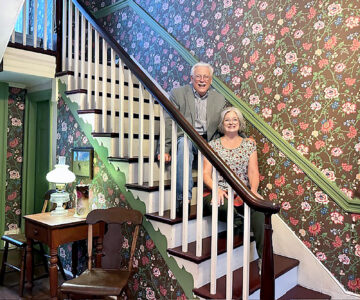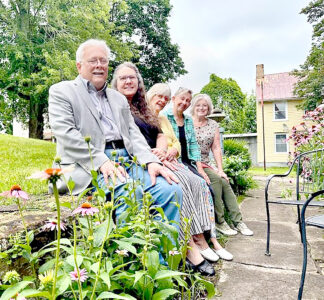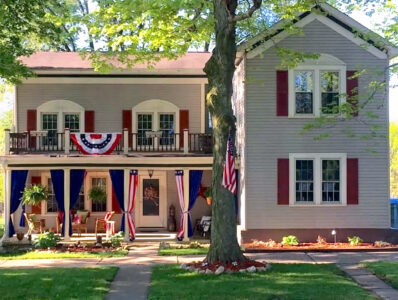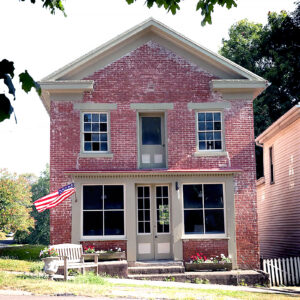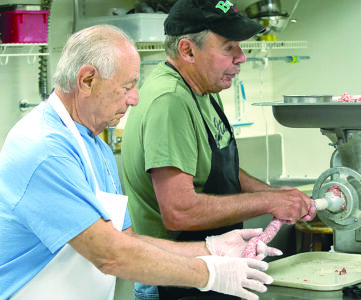Mount Pleasant … a significant part of history
Public tour to connect area residents with village’s past
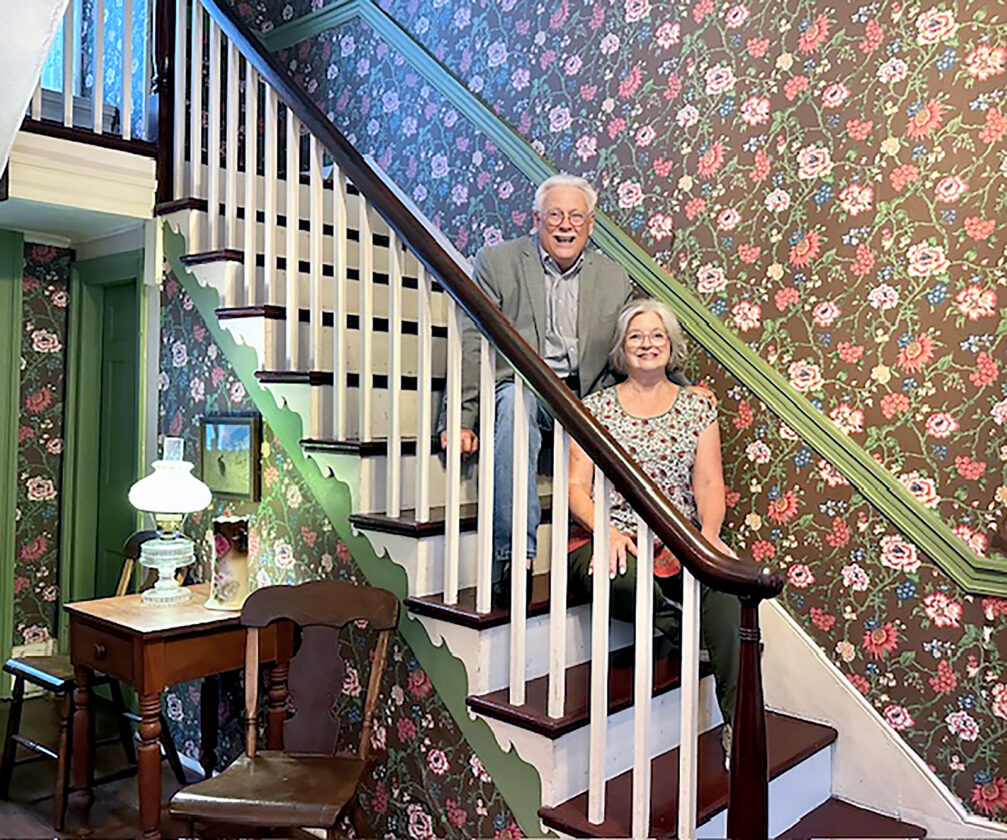
AN IMPORTANT VILLAGE IN AMERICAN HISTORY — Mount Pleasant Historical Society President Tom Haynes, along with Corresponding Secretary Nina Sutherland, sat on the stairway of the 1835 John Gill House, now referred to as the Elizabeth House Mansion Museum. According to Haynes, the house includes a gift shop, which will be open during the Aug. 2-3 historical Friends to Freedom Tour. The tour will be open to any area resident interested in learning about the village’s history. -- Contributed
MOUNT PLEASANT — Located within Jefferson County lies a small village.
A village many Ohio Valley residents often tend to forget.
Its population is below 400.
Its total area is a distance of .26 square miles.
Needless to say, it is a place that sometimes goes unnoticed.
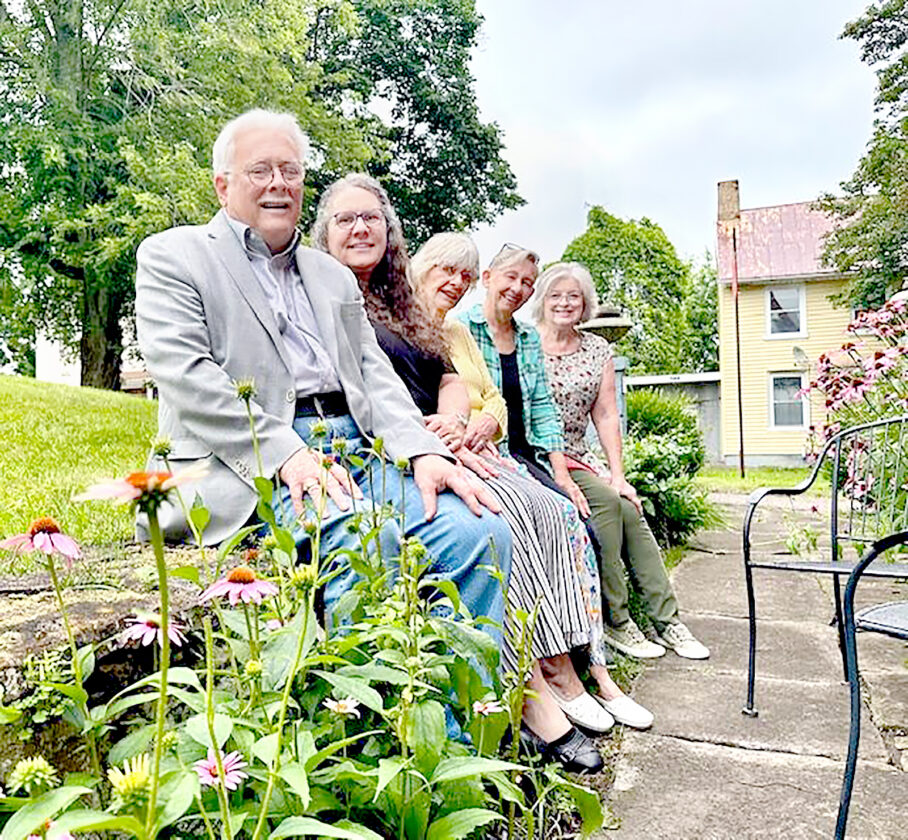
HISTORICAL SOCIETY PREPARES FOR TOUR — Members of the Mount Pleasant Historical Society sat along the garden wall at the village’s Elizabeth House Mansion, having gathered to make the final preparations for the village’s annual historical Friends to Freedom Tour. Tours will be offered Aug. 2-3. Historical society members include, from left, President Tom Haynes, members Annette Kendle and Sue Heins, Vice President Pam Dunn and Corresponding Secretary Nina Sutherland. -- Contributed
And yet, the history that lies within that forgotten village contains many significant moments … moments that helped shape America into what it has become today.
The village of Mount Pleasant will soon celebrate the 160th anniversary, which marks the end of the Civil War, as well as the abolishment of slavery in the United States.
Members of the Historical Society of Mount Pleasant have been preparing to show local residents a glimpse into the village’s past through its upcoming Friends to Freedom Tour.
This event is scheduled to take place from 10 a.m. to 5 p.m. on Aug. 2 and from 1 p.m. to 5 p.m. Aug. 3.
The tour, which takes between three to four hours to complete, will take visitors throughout the village, as well as through its National Historic Landmark District.
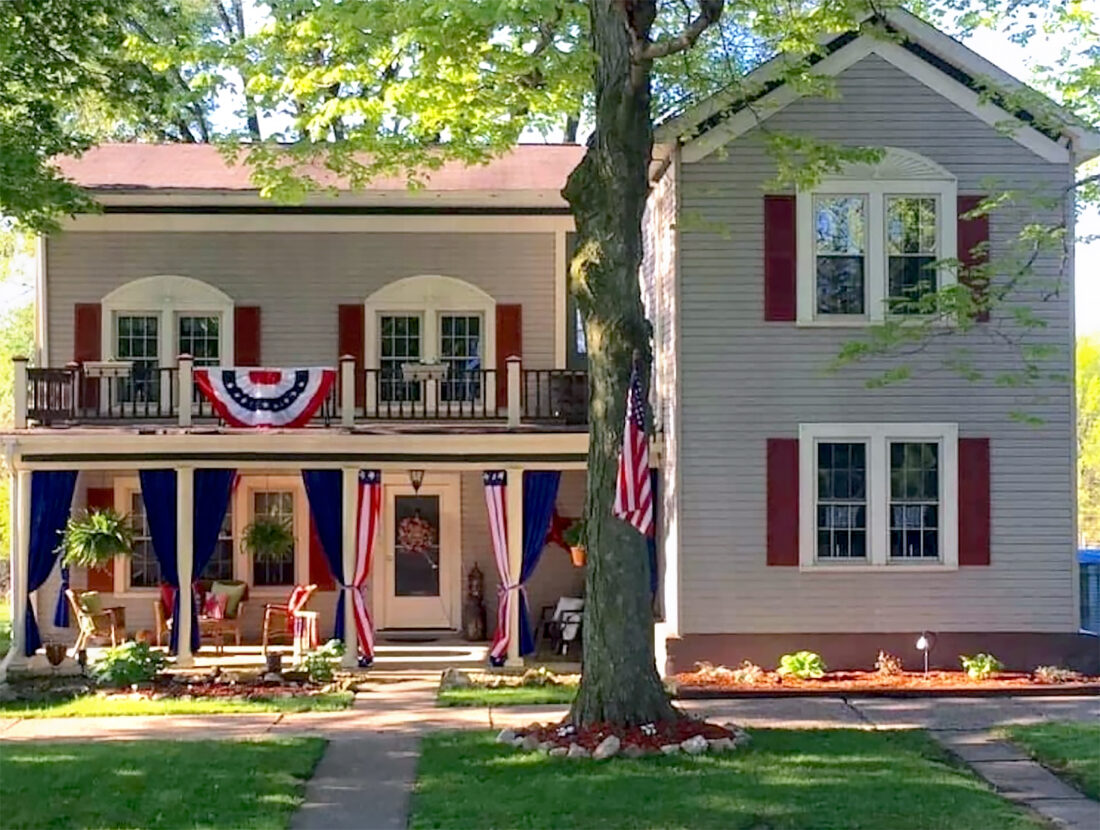
A VERY UNIQUE HOME — Within the village of Mount Pleasant lies a unique home owned by resident Gary Reynard. The house is two homes that were combined into one. The first belonging to J. Brown and built in 1830, while the other was constructed in 1918. Reynard purchased the home in 2011, as his family can be traced to Mount Pleasant back to 1827. -- Contributed
Founded in 1803, Mount Pleasant was an early hub for Eastern Ohio Quakers. Then, 11 years later in 1814, the first yearly meeting house west of the Alleghenies was established.
Today, the Quaker Yearly Meeting House is an Ohio state memorial and stands in tribute to the Quakers, known as the Society of Friends.
During its period of active use, there was a seating capacity for 2,000 people.
The three-story building is 60 by 92 foot and owned by the Ohio History Connection.
The building was constructed from locally produced peach bricks formed from area clay, which were fired on site.
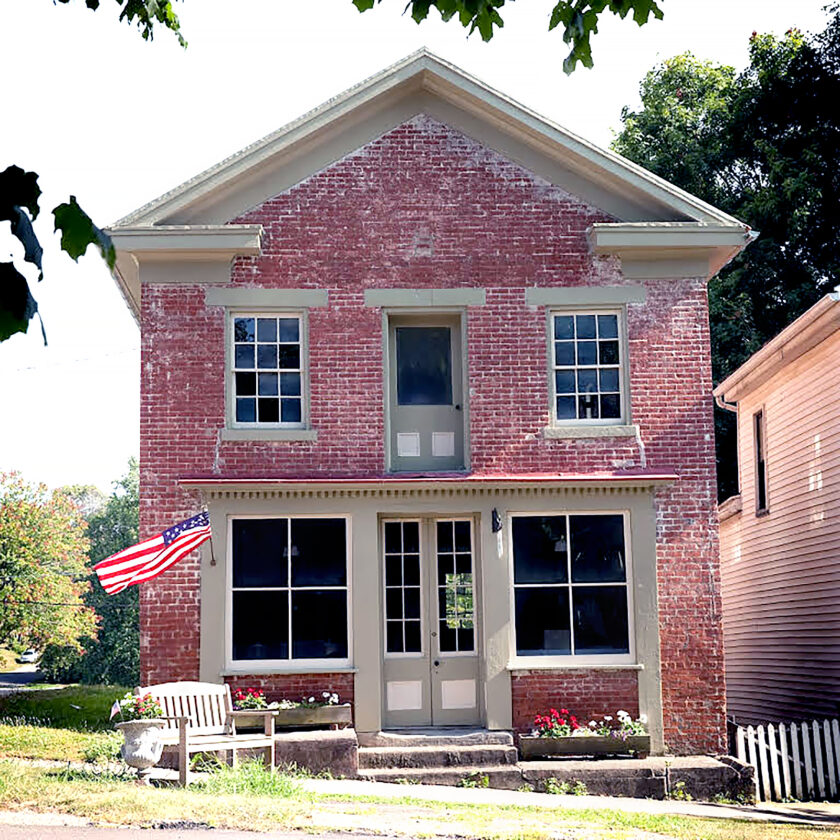
TIN SHOP –– The building that once served as a tin shop will be one of a dozen locations that will be viewed and discussed on the tour. -- Contributed
The meeting house will be among the dozen stops to be visited on the tour, according to officials, who added an “elaborate quilt show will be exhibited inside” the building.
Quaker Benjamin Lundy was considered the “father of American abolitionism.”
Lundy called Mount Pleasant home, as did numerous abolitionists and anti-slavery luminaries.
The tour will feature additional historical sites, including the Harris-Bone Log Cabin, built in 1804; the Tin Shop, constructed in 1840; the Historical Center, erected in 1856; the Burriss General Store, built in 1895; and the John Gill/Elizabeth House Mansion Museum, which encompasses a gift shop.
Additional sites will feature the Friends Church, built in 1856; the Samuel Gill House, built in 1846; and a walk-through of the summer kitchen of Israel French Jr., erected in 1816.
Guests will be able to enjoy homemade meals and desserts in the air-conditioned Tea Room during their visit to the Samuel Gill House.
Those on the tour will be able to sit on the patio of the Samuel Gill House, which offers a rest area.
The historical society’s itinerary includes touring a private home, three local churches and the porch of a residence that once belonged to a Civil War surgeon.
Those interested in taking the tour will see a total of 12 historical sites, including that porch area once belonging to that surgeon in the Civil War.
From that porch, guests will be shown “an excellent northern view of the Ohio foothills,” stated members of the historical society.
The porch has been restored so as to preserve its original character. The restoration was done by the home’s current owners, John and Joanne Curritti.
The Curritti’s home was built in 1846, and once belonged to the Honorable Jonathan Taylor Updegraff, a Quaker physician who served as a field surgeon during the Civil War.
Updegraff later became a state senator and congressman.
There is an oil painting of Joanne’s mother, Louise Alvarez, on display in the home, which is located next to the Elizabeth House.
Adjacent to the Updegraff home lies a drover’s camp, which showcases the early lives of those who drove cattle and sheep from place to place.
Within the camp lies a wagon once belonging to Mount Pleasant residents Bill and Mary Sutton.
The Suttons donated the wagon to the historical society. The couple’s son, Wes, will present insights into the camp on the tour, officials said.
The Friends to Freedom Tour will consist of a crowd favorite from past years — the home of Gary Reynard.
Located at 84 Union St., this particular structure is unique, in that it was the result of two homes being combined to form one.
The 1830 home of J. Brown, along with a home that was constructed in 1918, were united to create the present home.
Reynard exclaimed he can trace his Mount Pleasant family history to 1827 — one of the reasons why he knew from the moment he walked through the front door of the house in August 2011 — that this was to be his home.
Visitors will notice “an impressive early collection of Steubenville pottery, as well as an exhibition of paintings by local artist Harold Reynard, a great-great cousin of Gary,” on the tour, historical society members exclaimed.
Across the street from the Reynard home, those on the tour will be welcomed to the United Methodist Church and the First Presbyterian Church.
According to officials, “The Mount Pleasant Presbyterians had their early beginnings in 1798.”
Presbyterians held strict ideals about individual liberty. Those ideals were often compatible with the anti-slavery sentiment of their Quaker neighbors.
Following a fire at the church, a new structure was erected in 1937.
That building still stands and serves as today’s church, featuring many stained-glass windows.
The founder of the Methodist Church in Mount Pleasant was the Rev. David McMasters.
It was at the pastor’s home that a man by the name of David Stanton met a girl named Lucy Norman.
Stanton and Norman would become a couple and later married inside the village. The husband and wife became parents to a son they called Edwin McMasters Stanton, born Dec. 19, 1814.
Edwin McMasters Stanton would grow up and serve as President Abraham Lincoln’s secretary of war.
Other interesting historical facts which come out of Mount Pleasant include the names of Civil War soldiers which were carved into the outside bricks of the church.
Their names date back several generations. Many area residents may be able to locate some of their ancestor’s names among the bricks.
Mount Pleasant was also once a sanctuary for escaped slaves.
The village assisted slaves in reaching their freedom through the Underground Railroad, officials explained.
It was in Mount Pleasant that the first anti-slavery state convention in Ohio was held, taking place during the spring of 1837.
Underground Railroad stations still stand within the village. Among them are the Lundy/Free Labor Store, which was in operation from 1848 to 1857.
“This was the Quakers’ early economic effort to end slavery, where nothing was bought or sold that had been produced by slave labor,” officials commented.
“The structure is currently under a major restoration process by the Ohio History Connection,” historical society members said.
The annual Friends to Freedom Tour is held during the first weekend of August.
The event offers the opportunity for all Ohio Valley residents to see various historic sites, displays, artifacts and living history demonstrations.
Proceeds from the tour will go toward the maintenance and repair of these historical buildings, thus supporting the historical society, which is comprised solely of volunteers.
Its members include Tom Haynes, president; Annette Kendle, member; Sue Heins, member; Pam Dunn, vice president; and Nina Sutherland, corresponding secretary.
Tickets for the tour will cost $15 for adults. Children 12 and under who are accompanied by an adult will be permitted to take the tour free of charge.
Tickets can be purchased at the Burriss General Store, located at 311 Union St. or at the Elizabeth House Mansion Museum, located at 438 Union St. in Mount Pleasant.
- AN IMPORTANT VILLAGE IN AMERICAN HISTORY — Mount Pleasant Historical Society President Tom Haynes, along with Corresponding Secretary Nina Sutherland, sat on the stairway of the 1835 John Gill House, now referred to as the Elizabeth House Mansion Museum. According to Haynes, the house includes a gift shop, which will be open during the Aug. 2-3 historical Friends to Freedom Tour. The tour will be open to any area resident interested in learning about the village’s history. — Contributed
- HISTORICAL SOCIETY PREPARES FOR TOUR — Members of the Mount Pleasant Historical Society sat along the garden wall at the village’s Elizabeth House Mansion, having gathered to make the final preparations for the village’s annual historical Friends to Freedom Tour. Tours will be offered Aug. 2-3. Historical society members include, from left, President Tom Haynes, members Annette Kendle and Sue Heins, Vice President Pam Dunn and Corresponding Secretary Nina Sutherland. — Contributed
- A VERY UNIQUE HOME — Within the village of Mount Pleasant lies a unique home owned by resident Gary Reynard. The house is two homes that were combined into one. The first belonging to J. Brown and built in 1830, while the other was constructed in 1918. Reynard purchased the home in 2011, as his family can be traced to Mount Pleasant back to 1827. — Contributed
- TIN SHOP –– The building that once served as a tin shop will be one of a dozen locations that will be viewed and discussed on the tour. — Contributed

